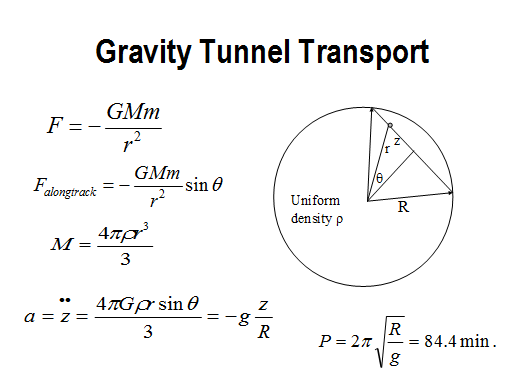
NOTES:
In Greg Benford's Tides of Light, a character named Killeen is dropped through a planet (long story). More recently, in John Cramer's Twistor, some valuable equipment takes the same kind of trip, when accidentally converted to a form of matter that is affected by no force but gravity. The question of what would happen in such a situation is interesting.
It turns out that if we assume the earth has a uniform density and isn't rotating, that travel through a straight, frictionless tunnel is very simple to analyze. The force on the object in the tunnel is given by this equation, but it is only the force parallel to the tunnel's length that matters, so we get this equation. What simplifies this equation is that once the object is at (say) this point along its path, the gravitational force of this part of the earth completely cancels out. Only the mass here matters (this fact was discovered by Newton himself). When this fact is incorporated into the equation, it simplifies to the equation for simple harmonic motion. The length of the tunnel drops out entirely, so the total travel time is constant regardless of whether the endpoints are Baltimore and DC or Baltimore and L.A. The duration of a round trip depends only on the acceleration of gravity at the earth's surface and the radius of the earth and equals 84.4 minutes. This turns out to be a period that turns up frequently. It's also the period of a satellite orbiting just above the earth's surface (even at 500 km the period is only 94 minutes) and the period of a pendulum whose length is the radius of the earth. Not surprisingly the maximum speed of something dropped through the tunnel is about 5 miles per second, which is orbital velocity at the surface of the earth.
By the way, by the standard of a story including any real science being labeled SF, then L. Frank Baum was a Science Fiction writer: his children's book Tik-Tok of Oz contains a tube through the earth from one side to another with a travel time of "more than an hour". In fact the inclusion of Tik-Tok makes L. Frank Baum one of the first Steampunk authors as well! (Thanks, Shannon, for this!)
It's interesting to see how the answer changes if you take into account the change in the density of the earth as a function of the earth's radius. When I first wondered about the effects of such variation I concentrated on the two obvious special cases:
By the way, I used to think that Arthur C. Clarke had gravity transport in mind in City and the Stars/Against the Fall of Night, but when I checked it out recently, it's not entirely clear that this is true.
